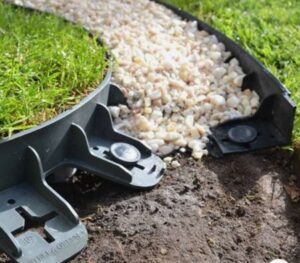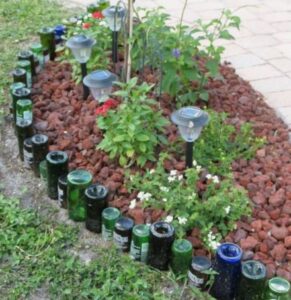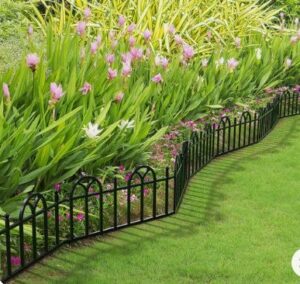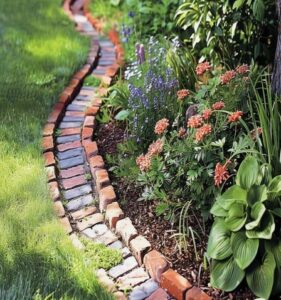When you’re in your garden and thinking about how garden edging can change the look, think about what’s possible. The right edging not only outlines your garden but also makes it look better.
There are many materials and styles to choose from, each with its own special look. It might feel overwhelming at first, but don’t worry. With some help and ideas, you can make your garden a beautiful and practical space.
Key Takeaways
You can choose from plastic, recycled, metal, stone, and wood edging materials to create borders in your garden. These materials are long-lasting and come in various styles to match your garden’s look. For a more eco-friendly option, consider recycled rubber or reclaimed wood. These edging options not only enhance the beauty of your garden but also serve a practical purpose.
Plastic Edging Options
If you want an affordable and long-lasting way to create neat borders in your garden beds, consider using plastic garden edging. Plastic edging is durable and cost-effective, making it popular among gardeners.
It’s easy to install, but the rolls can be a bit bulky, so having someone to help you out would be useful.

Recycled Material Edging Ideas
Looking for a cool and eco-friendly way to edge your garden? Try using recycled rubber!
It’s durable, easy to install, and helps the environment by reusing materials like rubber and plastic. This type of edging can handle different weather conditions without wearing out quickly.
Plus, it gives your garden a modern and sleek look, making it more attractive.

Metal Garden Edging Styles
Metal garden edging comes in different styles like steel, aluminum, and iron.
Steel edging gives a modern look with clean lines, is durable, and lasts long time.
Aluminum edging is lightweight, easy to install, and resistant to corrosion.
Iron edging offers a classic appearance with intricate designs and is sturdy and robust.
These metal edging styles are great for creating a stylish and long-lasting border for your garden.

Stone and Rock Edging Concepts
When choosing stone and rock edging for your garden, consider options like:
- White marble
- River rocks
- Colorful stones
- Bold boulders
These choices add style and character to your garden borders.

Rock Border Benefits
Stone and rock edging make your garden borders look nicer. They add a natural touch and make your outdoor space more attractive. Rock borders create a cool contrast with the green plants and flowers in your garden.
Stone edging gives your garden a rustic and natural look, and it defines different areas like garden beds and pathways. It’s tough and lasts a long time, with very little upkeep needed.
Stone Edging Styles
Looking to upgrade your garden borders? Here are some stylish stone edging options for a modern garden landscape:
- White Marble Stones: These elegant stones are perfect for contemporary homes and flower beds.
- Artic Rainbow Stones: Sparkling granite stones in various colors and sizes that add impact to landscaping.
- American Heritage Stones: Smooth and polished stones ideal for modern garden edging, available in different sizes for Zen gardens and flower beds.
Wood Border Designs
Consider using cedar wood borders for a charming and natural garden edging solution. Cedar wood is durable, rot-resistant, and requires minimal maintenance, making it a great choice for long-lasting borders. It adds elegance to your garden and is eco-friendly due to its sustainable nature.
You can also use reclaimed or repurposed wood for a unique and personalized touch that promotes environmental consciousness. Whether you prefer a classic design or something more creative, wood borders can enhance the overall look of your outdoor space and blend well with the natural surroundings.
Creative Edging Solutions
Looking to spruce up your garden borders? Here are some creative edging solutions to consider:
- Woven Willow: Woven willow edging gives a rustic and natural look to your garden. It can be curved around flower beds, adding a charming touch to your landscape.
- Landscape Timbers: Landscape timbers are versatile and provide a sturdy border for your garden. They can be easily cut to fit the shape of your garden beds, giving a neat appearance.
- Plastic Edge: Plastic edging is a durable and affordable option that comes in various styles. When combined with a spade edge, it gives a clean and classic look to your flowerbeds.
These unique edging solutions not only define your garden borders but also enhance the visual appeal of your outdoor space.
Living Edging Alternatives
Consider using plant borders and grass pathways as living edging alternatives in your garden. These natural elements can create a charming and defined border while adding a touch of greenery to your outdoor space.
Planting boxwood or lavender along the edges can bring a soft and organic feel to your garden design.
Plant Borders
Plant borders, also known as living edging alternatives, use plants to create boundaries in gardens. They’re a natural and soft option compared to using hard materials.
You can use low-growing plants such as boxwood, lavender, or mondo grass for your plant borders. These plants not only give a green border but also add texture and color to your garden.
Plant borders can separate different areas in your garden gently, making your outdoor space look better. You can customize your plant borders based on what you like, such as height, colors, and how much maintenance they need.
Grass Pathways
Planting low-growing grass varieties along your garden bed edges creates natural and organic borders. Grass pathways define garden borders and add a soft, textured look to your landscape. To maintain them, make sure to mow and trim regularly.
Grass edging not only beautifies your garden but also promotes a sustainable and eco-friendly environment. Enjoy the simple charm of grass pathways to enhance the beauty of your garden beds effortlessly.
Unique and Decorative Edging Ideas
Enhance your garden with these unique edging ideas:
- Seashell edging: Use local shells to create a coastal charm in your garden.
- Natural log edging: Add a touch of forest magic with logs for a rustic appeal.
- Metal edging: Opt for a sleek design for a modern aesthetic and durability.
Choose seashell edging for a beachy vibe, natural log for a rustic feel, or metal for a contemporary look. These edging ideas will elevate your garden’s decorative appeal.
Frequently Asked Questions
How Do You Make a Perfect Garden Edge?
You can create a nice garden edge by digging trenches or using recycled rubber edging. Choose natural materials for an eco-friendly and cost-effective option. Be creative with different designs to make your garden border look beautiful.
What Do Professional Landscapers Use for Edging?
Professional landscapers use metal, natural wood, paving blocks, natural stone, and brick for different looks. Metal for a modern style, wood for a cozy feel, paving blocks for a classy touch, natural stone for a seamless blend with nature, and brick for a traditional charm. Edging materials like these help create defined spaces with clean lines.
What Is the Best Type of Garden Edging?
When choosing garden edging, think about your style. Metal gives a modern look, while stone creates a classic feel. Natural materials blend well, but synthetic options last longer. Pick what fits your taste and garden style.
What is decorative edging?
Decorative edging helps define garden borders using materials like stone, wood, metal, or plastic. It offers creative options and budget-friendly solutions for keeping your garden neat and organized.
Conclusion
In simple terms, garden edging is a great way to make your outdoor space look neat and pretty. By using the right material and style for your edging, you can create borders that make your garden look even better.
Whether you like modern, eco-friendly, or rustic designs, there are lots of choices to match your taste and make your garden more charming.
Try out different edging ideas to give your outdoor area some extra style and personality.











